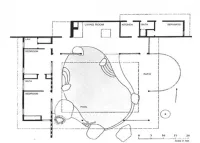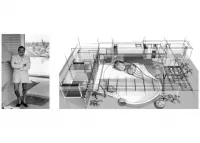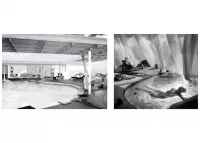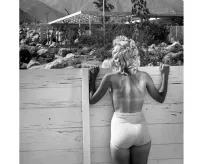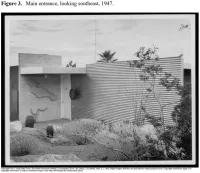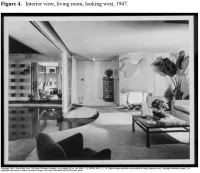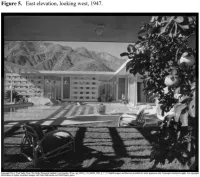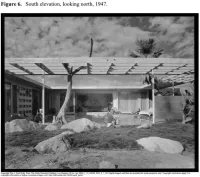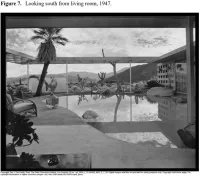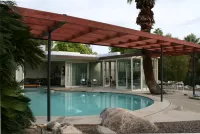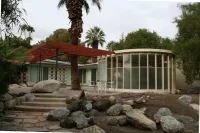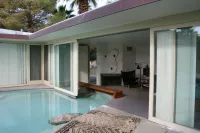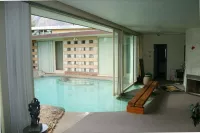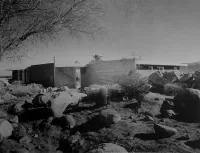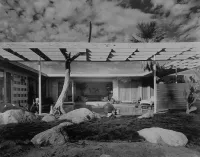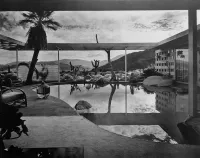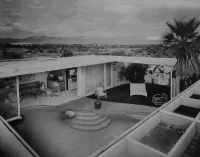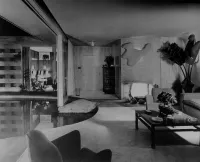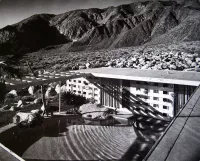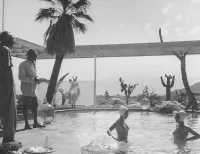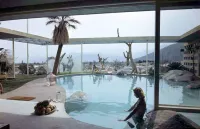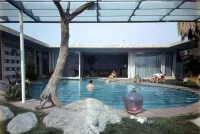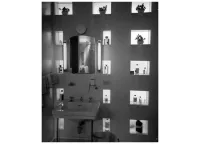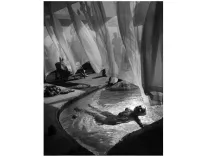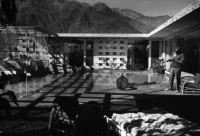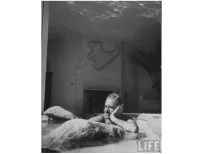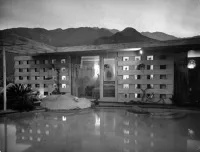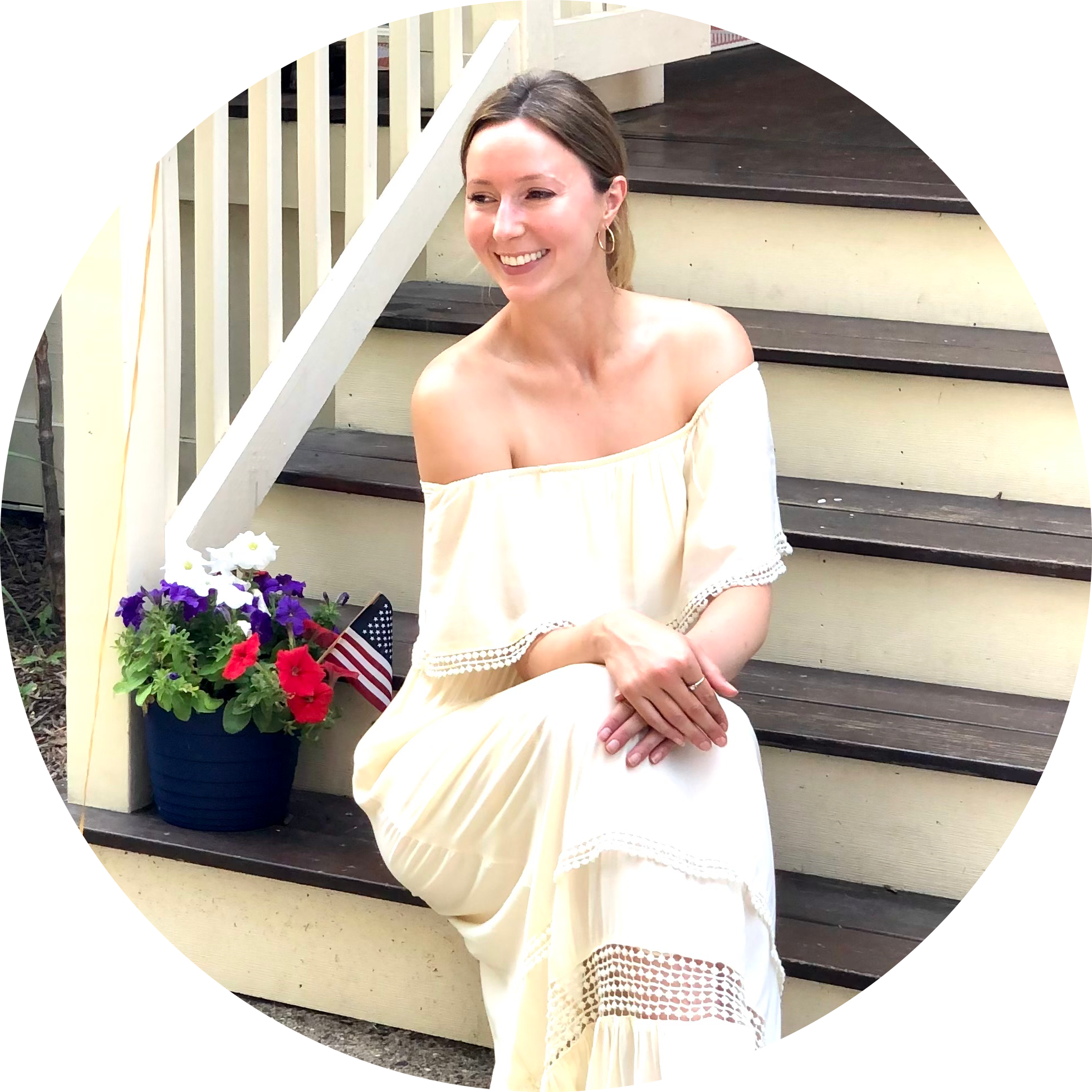Share what you know,
and discover more.
Share what you know,
and discover more.
Dec 07, 2016
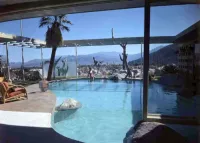
-

- Dave D
Tour an iconic Palm Springs home, the Loewy House, in 3D
Albert Frey’s home for designer Raymond Loewy was a streamlined symbol of Midcentury style By Patrick Sisson Industrial designer Raymond Loewy was one of the founders of the modern age, a skilled creative whose work spanned industries (from locomotives to the silhouette of the Coca-Cola bottle) and showcased a streamlined aesthetic inseparable from midcentury modern living. It makes sense that this Palm Springs retreat created for him by architect Albert Frey, initially meant as a bachelor pad when conceived and built in the late ‘40s, would showcase the same beautiful simplicity as Loewy’s work. A curved glass pavilion set amid the desert landscape, the home features a large illuminated pool which extended into the living room, making it a great setting for cocktail parties. Minimal to the extreme, the $60,000 residence fit the owner’s aesthetic and lifestyle. At the time, Frey’s stylish design sat across from a home Richard Neutra had designed for Edgar Kaufmann, a famous patron of Frank Lloyd Wright. This tour offers an undisturbed look at its original layout (it’s since been renovated and redesigned by subsequent owners). Swiss-born architect Frey, one of the founding fathers of Palm Springs modernism, had briefly worked for Le Corbusier early on in his career before moving to the United States and eventually falling in love with the California landscape. He created a series of iconic buildings in the area, such as the Tramway Gas Station, as well as a small home for himself on the summit of Mount San Jacinto. This virtual tour was created by Archilogic, a firm that specializes in creating 3D models for architecture and real estate, and allows users to upload floor plans and create their own virtual tours. Check out their tours of unbuilt Frank Lloyd Wright projects, including the Ralph Jester House and the Dr. Hugh Pratt Home. Recently, Archilogic officially released spaces.archilogic.com, which allows users to create their own virtual tours by signing up.
Tour an iconic Palm Springs home, the Loewy House, in 3D
Albert Frey’s home for designer Raymond Loewy was a streamlined symbol of Midcentury style By Patrick Sisson Industrial designer Raymond Loewy was one of the founders of the modern age, a skilled creative whose work spanned industries (from locomotives to the silhouette of the Coca-Cola bottle) and showcased a streamlined aesthetic inseparable from midcentury modern living. It makes sense that this Palm Springs retreat created for him by architect Albert Frey, initially meant as a bachelor pad when conceived and built in the late ‘40s, would showcase the same beautiful simplicity as Loewy’s work. A curved glass pavilion set amid the desert landscape, the home features a large illuminated pool which extended into the living room, making it a great setting for cocktail parties. Minimal to the extreme, the $60,000 residence fit the owner’s aesthetic and lifestyle. At the time, Frey’s stylish design sat across from a home Richard Neutra had designed for Edgar Kaufmann, a famous patron of Frank Lloyd Wright. This tour offers an undisturbed look at its original layout (it’s since been renovated and redesigned by subsequent owners). Swiss-born architect Frey, one of the founding fathers of Palm Springs modernism, had briefly worked for Le Corbusier early on in his career before moving to the United States and eventually falling in love with the California landscape. He created a series of iconic buildings in the area, such as the Tramway Gas Station, as well as a small home for himself on the summit of Mount San Jacinto. This virtual tour was created by Archilogic, a firm that specializes in creating 3D models for architecture and real estate, and allows users to upload floor plans and create their own virtual tours. Check out their tours of unbuilt Frank Lloyd Wright projects, including the Ralph Jester House and the Dr. Hugh Pratt Home. Recently, Archilogic officially released spaces.archilogic.com, which allows users to create their own virtual tours by signing up.
Dec 07, 2016
Tour an iconic Palm Springs home, the Loewy House, in 3D
Albert Frey’s home for designer Raymond Loewy was a streamlined symbol of Midcentury style By Patrick SissonIndustrial designer Raymond Loewy was one of the founders of the modern age, a skilled creative whose work spanned industries (from locomotives to the silhouette of the Coca-Cola bottle) and showcased a streamlined aesthetic inseparable from midcentury modern living. It makes sense that this Palm Springs retreat created for him by architect Albert Frey, initially meant as a bachelor pad when conceived and built in the late ‘40s, would showcase the same beautiful simplicity as Loewy’s work.
A curved glass pavilion set amid the desert landscape, the home features a large illuminated pool which extended into the living room, making it a great setting for cocktail parties. Minimal to the extreme, the $60,000 residence fit the owner’s aesthetic and lifestyle. At the time, Frey’s stylish design sat across from a home Richard Neutra had designed for Edgar Kaufmann, a famous patron of Frank Lloyd Wright. This tour offers an undisturbed look at its original layout (it’s since been renovated and redesigned by subsequent owners).
Swiss-born architect Frey, one of the founding fathers of Palm Springs modernism, had briefly worked for Le Corbusier early on in his career before moving to the United States and eventually falling in love with the California landscape. He created a series of iconic buildings in the area, such as the Tramway Gas Station, as well as a small home for himself on the summit of Mount San Jacinto.
This virtual tour was created by Archilogic, a firm that specializes in creating 3D models for architecture and real estate, and allows users to upload floor plans and create their own virtual tours. Check out their tours of unbuilt Frank Lloyd Wright projects, including the Ralph Jester House and the Dr. Hugh Pratt Home. Recently, Archilogic officially released spaces.archilogic.com, which allows users to create their own virtual tours by signing up.
Posted Date
Dec 22, 2021
Historical Record Date
Dec 07, 2016
Source Name
Curbed
Delete Story
Are you sure you want to delete this story?
Sep 15, 2015
Sep 15, 2015
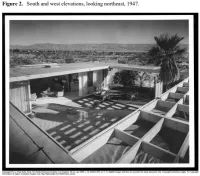
-

- Dave D
National Register of Historic Places - Summary
Summary The Loewy House of 1946 is located on the edge of the Little Tuscany neighborhood of Palm Springs. The single-family residence was designed by Albert Frey to take advantage of an extensive boulder pile on the site. The wood-framed house utilizes corrugated metal, floor-toceiling glass, and pecky cypress to create an indoor-outdoor flow. The property is in excellent condition and is able to convey its significance despite alterations. A freestanding pavilion with deck that was constructed in 1997 near the far southeastern corner of the property is differentiated from the main house by its highly utilitarian design. The small building consists of a stucco box with a flat roof and sliding glass doors. It is a noncontributing resource. Narrative Description This single-family residence incorporates some of the ideas that Albert Frey experimented with in his own home, Frey House I, designed in 1941. Frey convinced Loewy that he could design a house for him that took advantage of an extensive boulder pile sitting on the property that had been pushed there during the construction of an adjacent road. Similar to Frey House I, the Loewy house utilizes extended wall planes clad in corrugated metal, capped by a flat roof with extended eaves (Figure 2). Unlike Frey’s own house, Loewy’s is L-shaped in plan with bedrooms and bathroom on one wing, and the living room, servants’ quarters, and kitchen on the other. Upon approaching the main entrance, one encounters a north-facing elevation of corrugated metal and a west-facing Roman brick chimney (Figure 3). Attached to the chimney is a freeform decorative wood sculpture that appears in the earliest photographs of the house. As one steps into the dwelling, one encounters the unusual feature of a large boulder and a portion of the swimming pool entering the living room (Figure 4). This serves to dramatically blur the distinction between outside and inside. Loewy specified the pecky cypress (worm eaten wood) arranged in a checkerboard pattern used as cladding on portions of the east elevation facing the pool (Figure 5). Panels of translucent and clear glass enclose a curved dining room at the east end of the swimming pool. Another dramatic architectural element original to the house is the wood pergola supported by slender steel posts that extends from the main roof and surrounds the pool on its south and east sides (Figures 6 and 7). The sprawling boulder-strewn parcel is situated amongst large houses including the famous Kaufmann House by Richard Neutra just east and below the subject property. Building permits indicate that under Loewy’s ownership there was an addition to the house in 1950 that may have been described as a conservatory; the writing is mostly illegible. In 1952, Loewy commissioned an addition to the kitchen; in 1959, a laundry room was added. An addition of a bedroom and bathroom, and the enlargement of the kitchen, occurred in 1959. It appears that all of these alterations occurred at the east end of the house past the kitchen and servants’ quarters and are generally not visible from the living room or pool area. City directories confirm that Loewy resided at the subject property until at least 1962. In 1997, the owners added a room to the rear, east end of the dwelling that is not visible from the main portions of the house or pool area. That same year a small, noncontributing, freestanding pavilion with deck was constructed near the far southeastern corner of the property. It, too, is not visible from the main house. In 1999, an exterior hallway leading to a bedroom addition was constructed on the dwelling’s west elevation. The alterations are differentiated from the original design in the contemporary metal framing of the glazing, beige-painted vertically striated stucco finish, and shiny metal fascia. In addition, the hallway roof rises toward the south versus the flat roof of the original house. The circular dining room was originally an outdoor patio with its open end facing the swimming pool and its curved portion, open to the sky, partially enclosed by wood framed translucent glass panels. This semicircular open-air patio was later fully enclosed with glazing and a flat roof, and may be the conservatory referred to in the 1950 building permit. As relates to integrity, aspects of the building’s design, materials, and workmanship have been affected by the noted additions to the rear (west) and south ends of the house. Despite these alterations, the Loewy House is able to convey its architectural significance because it retains the key elements original to the house including a flat roof with extended eaves, corrugated aluminum cladding at the entrance, Roman brick chimney and fireplace, encroachment of the swimming pool and boulder into the living room, extensive use of floor-to-ceiling fixed and sliding glass panels, poolside pergola, and semicircular patio (since enclosed). The use of pecky cypress as exterior wall cladding is attributed to Loewy. As such, the building, in its desert setting, continues to evoke the feeling of a unique residence designed for a renowned industrial designer in its original location. Additional Integrity Discussion In response to the NPS reviewer's request for additional information regarding alterations and integrity, the following information is added to the National Register of Historic Places nomination on September 25, 2015. Loewy House is able to convey its architectural significance because it retains the key elements original to the house when viewed from the primary elevations facing the swimming pool within the dwelling's L-shaped footprint. Original to Loewy House are its flat roof with extended eaves, corrugated aluminum cladding at the entrance, Roman brick chimney and fireplace, encroachment of the swimming pool and boulder into the living room, extensive use of floor-to-ceiling fixed and sliding glass panels, semicircular patio (since enclosed), and poolside pergola. The use of pecky cypress as exterior wall cladding is attributed to Loewy. Among the dwelling's alterations, it appears that the earliest was the enclosure of the semicircular patio. Originally, its open end faced the swimming pool and its curved portion-open to the sky-was partially enclosed by wood framed translucent glass panels. A 1950 building permit indicates that under Loewy's ownership there was an addition to the house described as a "conservatory"; unfortunately the writing is mostly illegible. The semicircular, open-air patio that was subsequently fully enclosed with glazing and a flat roof may be the "conservatory" referred to in the 1950 building permit. In 1952, Loewy commissioned an addition to the kitchen; in 1959, the kitchen was enlarged and a laundry room was added at the east end of the house beyond the kitchen and servants' quarters. This addition is not visible from the living room or pool area. In 1997, subsequent owners added a room to the east end of the dwelling adjacent to the laundry room. Similar to the earlier additions, it is not visible from the main portions of the house or pool area. That same year a small noncontributing freestanding pavilion with deck was constructed near the far southeastern corner of the property. It, too, is not visible from the main house. In 1999, an exterior hallway was constructed on the dwelling's west elevation. The new hallway leads to the original bedrooms and a new bedroom constructed on the south end of the house. Following the Secretary of the Interior's Standards, the new construction is differentiated from the original design in the contemporary metal framing of the glazing, beige painted vertically striated stucco finish and shiny metal fascia. In addition, the hallway roof rises toward the south and is purposely recessed for limited visibility from the public and private spaces surrounding the central swimming pool. The hallway and bedroom addition are compatible with the historic features of the house because their materials, features, size, scale and proportion, and massing do not overwhelm the original design. Due to the dwelling being situated away from the road behind solid gates and somewhat submerged behind a field of large boulders, Loewy House is barely visible from the public right-of-way. Similarly, when approaching the main entrance, the west elevation that was added in 1999 is generally hidden by the original projecting corrugated metal wall designed by Frey. In addition, the building's north, east, and south elevations are completely obscured by vegetation and not visible to the public. As a result, the primary elevations are not the exterior elevations but, instead, are those elevations visible from the living room, bedrooms, glass-enclosed dining room, and swimming pool. From these vantage points, Loewy House exhibits a high level of integrity with the noted alterations not compromising the property's eligibility.
National Register of Historic Places - Summary
Summary The Loewy House of 1946 is located on the edge of the Little Tuscany neighborhood of Palm Springs. The single-family residence was designed by Albert Frey to take advantage of an extensive boulder pile on the site. The wood-framed house utilizes corrugated metal, floor-toceiling glass, and pecky cypress to create an indoor-outdoor flow. The property is in excellent condition and is able to convey its significance despite alterations. A freestanding pavilion with deck that was constructed in 1997 near the far southeastern corner of the property is differentiated from the main house by its highly utilitarian design. The small building consists of a stucco box with a flat roof and sliding glass doors. It is a noncontributing resource. Narrative Description This single-family residence incorporates some of the ideas that Albert Frey experimented with in his own home, Frey House I, designed in 1941. Frey convinced Loewy that he could design a house for him that took advantage of an extensive boulder pile sitting on the property that had been pushed there during the construction of an adjacent road. Similar to Frey House I, the Loewy house utilizes extended wall planes clad in corrugated metal, capped by a flat roof with extended eaves (Figure 2). Unlike Frey’s own house, Loewy’s is L-shaped in plan with bedrooms and bathroom on one wing, and the living room, servants’ quarters, and kitchen on the other. Upon approaching the main entrance, one encounters a north-facing elevation of corrugated metal and a west-facing Roman brick chimney (Figure 3). Attached to the chimney is a freeform decorative wood sculpture that appears in the earliest photographs of the house. As one steps into the dwelling, one encounters the unusual feature of a large boulder and a portion of the swimming pool entering the living room (Figure 4). This serves to dramatically blur the distinction between outside and inside. Loewy specified the pecky cypress (worm eaten wood) arranged in a checkerboard pattern used as cladding on portions of the east elevation facing the pool (Figure 5). Panels of translucent and clear glass enclose a curved dining room at the east end of the swimming pool. Another dramatic architectural element original to the house is the wood pergola supported by slender steel posts that extends from the main roof and surrounds the pool on its south and east sides (Figures 6 and 7). The sprawling boulder-strewn parcel is situated amongst large houses including the famous Kaufmann House by Richard Neutra just east and below the subject property. Building permits indicate that under Loewy’s ownership there was an addition to the house in 1950 that may have been described as a conservatory; the writing is mostly illegible. In 1952, Loewy commissioned an addition to the kitchen; in 1959, a laundry room was added. An addition of a bedroom and bathroom, and the enlargement of the kitchen, occurred in 1959. It appears that all of these alterations occurred at the east end of the house past the kitchen and servants’ quarters and are generally not visible from the living room or pool area. City directories confirm that Loewy resided at the subject property until at least 1962. In 1997, the owners added a room to the rear, east end of the dwelling that is not visible from the main portions of the house or pool area. That same year a small, noncontributing, freestanding pavilion with deck was constructed near the far southeastern corner of the property. It, too, is not visible from the main house. In 1999, an exterior hallway leading to a bedroom addition was constructed on the dwelling’s west elevation. The alterations are differentiated from the original design in the contemporary metal framing of the glazing, beige-painted vertically striated stucco finish, and shiny metal fascia. In addition, the hallway roof rises toward the south versus the flat roof of the original house. The circular dining room was originally an outdoor patio with its open end facing the swimming pool and its curved portion, open to the sky, partially enclosed by wood framed translucent glass panels. This semicircular open-air patio was later fully enclosed with glazing and a flat roof, and may be the conservatory referred to in the 1950 building permit. As relates to integrity, aspects of the building’s design, materials, and workmanship have been affected by the noted additions to the rear (west) and south ends of the house. Despite these alterations, the Loewy House is able to convey its architectural significance because it retains the key elements original to the house including a flat roof with extended eaves, corrugated aluminum cladding at the entrance, Roman brick chimney and fireplace, encroachment of the swimming pool and boulder into the living room, extensive use of floor-to-ceiling fixed and sliding glass panels, poolside pergola, and semicircular patio (since enclosed). The use of pecky cypress as exterior wall cladding is attributed to Loewy. As such, the building, in its desert setting, continues to evoke the feeling of a unique residence designed for a renowned industrial designer in its original location. Additional Integrity Discussion In response to the NPS reviewer's request for additional information regarding alterations and integrity, the following information is added to the National Register of Historic Places nomination on September 25, 2015. Loewy House is able to convey its architectural significance because it retains the key elements original to the house when viewed from the primary elevations facing the swimming pool within the dwelling's L-shaped footprint. Original to Loewy House are its flat roof with extended eaves, corrugated aluminum cladding at the entrance, Roman brick chimney and fireplace, encroachment of the swimming pool and boulder into the living room, extensive use of floor-to-ceiling fixed and sliding glass panels, semicircular patio (since enclosed), and poolside pergola. The use of pecky cypress as exterior wall cladding is attributed to Loewy. Among the dwelling's alterations, it appears that the earliest was the enclosure of the semicircular patio. Originally, its open end faced the swimming pool and its curved portion-open to the sky-was partially enclosed by wood framed translucent glass panels. A 1950 building permit indicates that under Loewy's ownership there was an addition to the house described as a "conservatory"; unfortunately the writing is mostly illegible. The semicircular, open-air patio that was subsequently fully enclosed with glazing and a flat roof may be the "conservatory" referred to in the 1950 building permit. In 1952, Loewy commissioned an addition to the kitchen; in 1959, the kitchen was enlarged and a laundry room was added at the east end of the house beyond the kitchen and servants' quarters. This addition is not visible from the living room or pool area. In 1997, subsequent owners added a room to the east end of the dwelling adjacent to the laundry room. Similar to the earlier additions, it is not visible from the main portions of the house or pool area. That same year a small noncontributing freestanding pavilion with deck was constructed near the far southeastern corner of the property. It, too, is not visible from the main house. In 1999, an exterior hallway was constructed on the dwelling's west elevation. The new hallway leads to the original bedrooms and a new bedroom constructed on the south end of the house. Following the Secretary of the Interior's Standards, the new construction is differentiated from the original design in the contemporary metal framing of the glazing, beige painted vertically striated stucco finish and shiny metal fascia. In addition, the hallway roof rises toward the south and is purposely recessed for limited visibility from the public and private spaces surrounding the central swimming pool. The hallway and bedroom addition are compatible with the historic features of the house because their materials, features, size, scale and proportion, and massing do not overwhelm the original design. Due to the dwelling being situated away from the road behind solid gates and somewhat submerged behind a field of large boulders, Loewy House is barely visible from the public right-of-way. Similarly, when approaching the main entrance, the west elevation that was added in 1999 is generally hidden by the original projecting corrugated metal wall designed by Frey. In addition, the building's north, east, and south elevations are completely obscured by vegetation and not visible to the public. As a result, the primary elevations are not the exterior elevations but, instead, are those elevations visible from the living room, bedrooms, glass-enclosed dining room, and swimming pool. From these vantage points, Loewy House exhibits a high level of integrity with the noted alterations not compromising the property's eligibility.
National Register of Historic Places - Summary
SummaryThe Loewy House of 1946 is located on the edge of the Little Tuscany neighborhood of Palm Springs. The single-family residence was designed by Albert Frey to take advantage of an extensive boulder pile on the site. The wood-framed house utilizes corrugated metal, floor-toceiling glass, and pecky cypress to create an indoor-outdoor flow. The property is in excellent condition and is able to convey its significance despite alterations. A freestanding pavilion with deck that was constructed in 1997 near the far southeastern corner of the property is differentiated from the main house by its highly utilitarian design. The small building consists of a stucco box with a flat roof and sliding glass doors. It is a noncontributing resource.
Narrative Description
This single-family residence incorporates some of the ideas that Albert Frey experimented with in his own home, Frey House I, designed in 1941. Frey convinced Loewy that he could design a house for him that took advantage of an extensive boulder pile sitting on the property that had been pushed there during the construction of an adjacent road. Similar to Frey House I, the Loewy house utilizes extended wall planes clad in corrugated metal, capped by a flat roof with extended eaves (Figure 2). Unlike Frey’s own house, Loewy’s is L-shaped in plan with bedrooms and bathroom on one wing, and the living room, servants’ quarters, and kitchen on the other. Upon approaching the main entrance, one encounters a north-facing elevation of corrugated metal and a west-facing Roman brick chimney (Figure 3). Attached to the chimney is a freeform decorative wood sculpture that appears in the earliest photographs of the house. As one steps into the dwelling, one encounters the unusual feature of a large boulder and a portion of the swimming pool entering the living room (Figure 4). This serves to dramatically blur the distinction between outside and inside. Loewy specified the pecky cypress (worm eaten wood) arranged in a checkerboard pattern used as cladding on portions of the east elevation facing the pool (Figure 5). Panels of translucent and clear glass enclose a curved dining room at the east end of the swimming pool. Another dramatic architectural element original to the house is the wood pergola supported by slender steel posts that extends from the main roof and surrounds the pool on its south and east sides (Figures 6 and 7).
The sprawling boulder-strewn parcel is situated amongst large houses including the famous Kaufmann House by Richard Neutra just east and below the subject property. Building permits indicate that under Loewy’s ownership there was an addition to the house in 1950 that may have been described as a conservatory; the writing is mostly illegible. In 1952, Loewy commissioned an addition to the kitchen; in 1959, a laundry room was added. An addition of a bedroom and bathroom, and the enlargement of the kitchen, occurred in 1959. It appears that all of these alterations occurred at the east end of the house past the kitchen and servants’ quarters and are generally not visible from the living room or pool area. City directories confirm that Loewy resided at the subject property until at least 1962.
In 1997, the owners added a room to the rear, east end of the dwelling that is not visible from the main portions of the house or pool area. That same year a small, noncontributing, freestanding pavilion with deck was constructed near the far southeastern corner of the property. It, too, is not visible from the main house. In 1999, an exterior hallway leading to a bedroom addition was constructed on the dwelling’s west elevation. The alterations are differentiated from the original design in the contemporary metal framing of the glazing, beige-painted vertically striated stucco finish, and shiny metal fascia. In addition, the hallway roof rises toward the south versus the flat roof of the original house. The circular dining room was originally an outdoor patio with its open end facing the swimming pool and its curved portion, open to the sky, partially enclosed by wood framed translucent glass panels. This semicircular open-air patio was later fully enclosed with glazing and a flat roof, and may be the conservatory referred to in the 1950 building permit.
As relates to integrity, aspects of the building’s design, materials, and workmanship have been affected by the noted additions to the rear (west) and south ends of the house. Despite these alterations, the Loewy House is able to convey its architectural significance because it retains the key elements original to the house including a flat roof with extended eaves, corrugated aluminum cladding at the entrance, Roman brick chimney and fireplace, encroachment of the swimming pool and boulder into the living room, extensive use of floor-to-ceiling fixed and sliding glass panels, poolside pergola, and semicircular patio (since enclosed). The use of pecky cypress as exterior wall cladding is attributed to Loewy. As such, the building, in its desert setting, continues to evoke the feeling of a unique residence designed for a renowned industrial designer in its original location.
Additional Integrity Discussion
In response to the NPS reviewer's request for additional information regarding alterations and integrity, the following information is added to the National Register of Historic Places nomination on September 25, 2015.
Loewy House is able to convey its architectural significance because it retains the key elements original to the house when viewed from the primary elevations facing the swimming pool within the dwelling's L-shaped footprint.
Original to Loewy House are its flat roof with extended eaves, corrugated aluminum cladding at the entrance, Roman brick chimney and fireplace, encroachment of the swimming pool and boulder into the living room, extensive use of floor-to-ceiling fixed and sliding glass panels, semicircular patio (since enclosed), and poolside pergola. The use of pecky cypress as exterior wall cladding is attributed to Loewy.
Among the dwelling's alterations, it appears that the earliest was the enclosure of the semicircular patio. Originally, its open end faced the swimming pool and its curved portion-open to the sky-was partially enclosed by wood framed translucent glass panels. A 1950 building permit indicates that under Loewy's ownership there was an addition to the house described as a "conservatory"; unfortunately the writing is mostly illegible. The semicircular, open-air patio that was subsequently fully enclosed with glazing and a flat roof may be the "conservatory" referred to in the 1950 building permit.
In 1952, Loewy commissioned an addition to the kitchen; in 1959, the kitchen was enlarged and a laundry room was added at the east end of the house beyond the kitchen and servants' quarters. This addition is not visible from the living room or pool area. In 1997, subsequent owners added a room to the east end of the dwelling adjacent to the laundry room. Similar to the earlier additions, it is not visible from the main portions of the house or pool area. That same year a small noncontributing freestanding pavilion with deck was constructed near the far southeastern corner of the property. It, too, is not visible from the main house.
In 1999, an exterior hallway was constructed on the dwelling's west elevation. The new hallway leads to the original bedrooms and a new bedroom constructed on the south end of the house. Following the Secretary of the Interior's Standards, the new construction is differentiated from the original design in the contemporary metal framing of the glazing, beige painted vertically striated stucco finish and shiny metal fascia. In addition, the hallway roof rises toward the south and is purposely recessed for limited visibility from the public and private spaces surrounding the central swimming pool. The hallway and bedroom addition are compatible with the historic features of the house because their materials, features, size, scale and proportion, and massing do not overwhelm the original design.
Due to the dwelling being situated away from the road behind solid gates and somewhat submerged behind a field of large boulders, Loewy House is barely visible from the public right-of-way. Similarly, when approaching the main entrance, the west elevation that was added in 1999 is generally hidden by the original projecting corrugated metal wall designed by Frey. In addition, the building's north, east, and south elevations are completely obscured by vegetation and not visible to the public. As a result, the primary elevations are not the exterior elevations but, instead, are those elevations visible from the living room, bedrooms, glass-enclosed dining room, and swimming pool. From these vantage points, Loewy House exhibits a high level of integrity with the noted alterations not compromising the property's eligibility.
Posted Date
Dec 22, 2021
Historical Record Date
Sep 15, 2015
Source Name
United States Department of the Interior - National Park Service
Delete Story
Are you sure you want to delete this story?
Mar 01, 1950
Mar 01, 1950
600 W Panorama Rd, Palm Springs, CA 92262, USA
Posted Date
Nov 03, 2025
Historical Record Date
Mar 01, 1950
Source Name
Hidden Architecture
Source Website
Delete Story
Are you sure you want to delete this story?
Mar 01, 1950
Mar 01, 1950
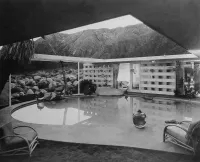
-

- Dave D
Photos of the Loewy House from the 1940s & 1950s
Loewy House Palm Springs, CA, United States. 1946 Architect: Albert Frey The Lowey House consists of two long, narrow rectangles at right angles to each other which surround a pool that passes under one of the sides of the house. The only strong vertical element is the back of the fireplace, which denotes the entry, located at the intersection of the two rectangles. At this junction, the walls become static, and separate and differentiate the outside from inside. On entering the house, one passes through another wall to find oneself outside again. To enter a room, one must again pass through one of the wall planes. The pool comes into the house, also blurring the distinction between the outside and inside. These elements break the boundaries of enclosure in the same way that the roof projects into the desert to claim part of the landscape as a private space. Loewy contributed to the design of the house with pickled wood around the pool area, the interior furnishings, and the cosmetic streamlining of the living room ceiling.
Photos of the Loewy House from the 1940s & 1950s
Loewy House Palm Springs, CA, United States. 1946 Architect: Albert Frey The Lowey House consists of two long, narrow rectangles at right angles to each other which surround a pool that passes under one of the sides of the house. The only strong vertical element is the back of the fireplace, which denotes the entry, located at the intersection of the two rectangles. At this junction, the walls become static, and separate and differentiate the outside from inside. On entering the house, one passes through another wall to find oneself outside again. To enter a room, one must again pass through one of the wall planes. The pool comes into the house, also blurring the distinction between the outside and inside. These elements break the boundaries of enclosure in the same way that the roof projects into the desert to claim part of the landscape as a private space. Loewy contributed to the design of the house with pickled wood around the pool area, the interior furnishings, and the cosmetic streamlining of the living room ceiling.
Photos of the Loewy House from the 1940s & 1950s
Loewy House Palm Springs, CA, United States. 1946Architect: Albert Frey
The Lowey House consists of two long, narrow rectangles at right angles to each other which surround a pool that passes under one of the sides of the house. The only strong vertical element is the back of the fireplace, which denotes the entry, located at the intersection of the two rectangles. At this junction, the walls become static, and separate and differentiate the outside from inside. On entering the house, one passes through another wall to find oneself outside again. To enter a room, one must again pass through one of the wall planes. The pool comes into the house, also blurring the distinction between the outside and inside. These elements break the boundaries of enclosure in the same way that the roof projects into the desert to claim part of the landscape as a private space. Loewy contributed to the design of the house with pickled wood around the pool area, the interior furnishings, and the cosmetic streamlining of the living room ceiling.
Posted Date
Dec 22, 2021
Historical Record Date
Mar 01, 1950
Source Name
Hidden Architecture
Source Website
Delete Story
Are you sure you want to delete this story?
Mar 01, 1949
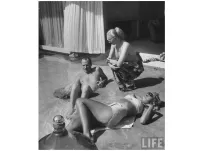
-

- Dave D
Life Magazine
A favorite pastime is raiding Google's archive of previously-unseen Life Magazine photos. There are three pages of film on Raymond Loewy, who was apparently quite the partier (check out his crib, above and below). This, friends, is the Father of Industrial Design's bathroom, circa 1949.
Life Magazine
A favorite pastime is raiding Google's archive of previously-unseen Life Magazine photos. There are three pages of film on Raymond Loewy, who was apparently quite the partier (check out his crib, above and below). This, friends, is the Father of Industrial Design's bathroom, circa 1949.
Mar 01, 1949
Life Magazine
A favorite pastime is raiding Google's archive of previously-unseen Life Magazine photos. There are three pages of film on Raymond Loewy, who was apparently quite the partier (check out his crib, above and below).This, friends, is the Father of Industrial Design's bathroom, circa 1949.
Posted Date
Dec 22, 2021
Historical Record Date
Mar 01, 1949
Source Name
Core77
Delete Story
Are you sure you want to delete this story?


